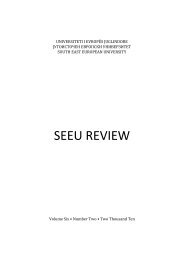SEEU Review vol. 5 Nr. 2 (pdf) - South East European University
SEEU Review vol. 5 Nr. 2 (pdf) - South East European University
SEEU Review vol. 5 Nr. 2 (pdf) - South East European University
You also want an ePaper? Increase the reach of your titles
YUMPU automatically turns print PDFs into web optimized ePapers that Google loves.
<strong>SEEU</strong> <strong>Review</strong> Volume 5, No. 2, 2009<br />
consistency between what most of the students in one class confirmed to be<br />
motivating and what factors they considered to be mostly positive.<br />
Present Study III: Teacher Questionnaire<br />
A similar questionnaire to the student questionnaire was given to the six<br />
teachers that were observed. Since six classrooms were observed, six<br />
teachers received a questionnaire. The teachers filled in their questionnaires<br />
(See Appendix D, for Teacher Questionnaire) while the students completed<br />
theirs. The purpose of the teacher questionnaire was to see the comparison<br />
between the teachers in evaluating their own teaching and the students’<br />
answers. Although the teachers might be subjective at some points and have<br />
a higher opinion of their teaching, the student questionnaires and certainly<br />
the observation checklist together helped to create a clearer picture of the<br />
actual teaching and to get reliable and valid results.<br />
Findings<br />
In order to obtain results in a more effective way, the rubric was created<br />
and some categories were designed. The rubric created was supposed to<br />
collect and compare the findings from all three sources -- the student<br />
questionnaires, the teacher questionnaires and the observation checklist. The<br />
rubric was divided into four parts and it included the information about:<br />
Learner, Teacher, Materials + Tasks and Classroom Management. For a<br />
better clarification and identification each class was given a letter from A- F,<br />
since the names of the teachers were not displayed anywhere. (See Appendix<br />
E representing the rubric used to compare the findings from each class).<br />
The findings for class A revealed that the students relied on the teacher<br />
for their motivation because the teacher was mentioned as a motivating<br />
factor many times. Students’ responses seemed to indicate that they needed<br />
to have their teacher encourage their self-motivation and goals in the class in<br />
order to learn. Generally, according to the researcher this teacher used most<br />
of the strategies that measure motivation Finally, the students were highly<br />
motivated by the teacher and there was good understanding and mutual trust<br />
between teacher and students. It can be seen that the students, while<br />
generally very positive, also indicated that the researcher’s observation<br />
captured some of their viewpoints too. Since the teacher possessed most of<br />
147

















